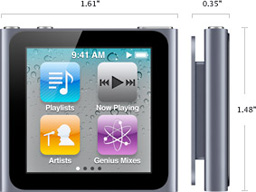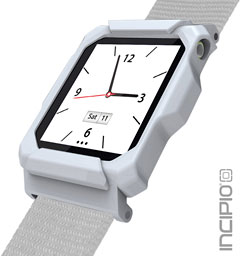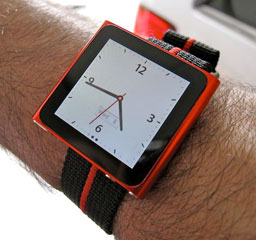"We are very careful about what features we add,
because we can't take them away." - Steve Jobs
The new iPod nano offers less than the old one - no
camera, no video, no microphone for voice recording, and a smaller
screen in a smaller iPod - yet Apple wants to charge the same money
($149 for 8 GB, $179 for 16).
 The 6G Nano looks like a larger iPod shuffle with a screen, but it
costs $100 more. It looks like so much less iPod than the iPod touch
that many may ignore it.
The 6G Nano looks like a larger iPod shuffle with a screen, but it
costs $100 more. It looks like so much less iPod than the iPod touch
that many may ignore it.
Maybe this easy upsell to the iPod touch is what Apple wants, but
there is a large gap between the $229 8 GB Touch and the $49
Shuffle, and large gaps encourage competition.
6G iPod nano a Misstep?
The penalty for this kind of misstep is that iPod sales numbers may
take a further hit unless many more people buy the iPod touch, and in
times like these, that's a gamble. The iPod nano can still be
successful, but Apple needs to remember what last year's iPod models
offered and what this year's models have, and then price the Nano so
it's attractive, not just a gap filler between the Shuffle and the iPod
touch.
 "Less is more" can work well in a new range. Apple has
shown that time and time again. But the iPod nano is not a new range;
it has history. The rules of electronics apply: If it is to stay
successful over time, any electronic device needs to get better and
cheaper.
"Less is more" can work well in a new range. Apple has
shown that time and time again. But the iPod nano is not a new range;
it has history. The rules of electronics apply: If it is to stay
successful over time, any electronic device needs to get better and
cheaper.
This year's iPod shuffle has the same memory, has gone to a design
with the best of the controls from the last two years, and is $10
cheaper. This year's iPod touch has a new, much better screen, a faster
processor, and two cameras. The entry model costs $30 more, but the 32
GB and 64 GB models still cost $299 and $399. This year's iPod Classic
is the same as last year's, but it too has a history of adding more
capacity and more functionality for the same money.
This year's iPod nano has gained an iOS-like multitouch interface,
but how many people are willing to pay for better controls on an iPod
that offers less features? It's an attempt to take the iOS interface to
ever cheaper devices, to devices that don't need a large screen, but to
succeed, the Nano needs to be seen as value for money and, if possible,
enter new markets.
Enter the iWatch
 An Apple Director will be using the Nano as a wristwatch,
according to Steve Jobs, and companies are already offering wrist bands
that work with the 6G Nano's clip. The watch app looks great, but the
Nano is oversized for anyone without a large wrist, so Apple needs to
encourage other ways of wearing it, perhaps as a pendant on a chain or
lanyard or as a pocket watch, as well as showing the Nano clipped to
this year's fashions.
An Apple Director will be using the Nano as a wristwatch,
according to Steve Jobs, and companies are already offering wrist bands
that work with the 6G Nano's clip. The watch app looks great, but the
Nano is oversized for anyone without a large wrist, so Apple needs to
encourage other ways of wearing it, perhaps as a pendant on a chain or
lanyard or as a pocket watch, as well as showing the Nano clipped to
this year's fashions.
 Watches are a strong part of the jewelry market, but
customising them has been expensive - until now. If Apple lets you
choose a photo background with an app, everyone can customise their
Nano watch to their heart's content. The backgrounds could be album
covers from your music library, photos from your library, or imports
(like iconic buildings or 20 famous paintings from the Louvre or Met).
You could change the background every day to suit your mood or have it
update every hour, so that at the end of the day, the Mona Lisa
tells you it's time to go home.
Watches are a strong part of the jewelry market, but
customising them has been expensive - until now. If Apple lets you
choose a photo background with an app, everyone can customise their
Nano watch to their heart's content. The backgrounds could be album
covers from your music library, photos from your library, or imports
(like iconic buildings or 20 famous paintings from the Louvre or Met).
You could change the background every day to suit your mood or have it
update every hour, so that at the end of the day, the Mona Lisa
tells you it's time to go home.
Adjusting Price Points
 The Nano as the totally customisable music watch
will do better at different price points too. A $99 4 GB version
without a pedometer and a simple black or white case would fill the
large gap between the Shuffle and the other iPods. The $149 Nano should
ideally be the 16 GB version and, if that is possible, the 8 GB
version could be dropped. Then the more expensive Nano would offer a
wide range of colored cases, much more memory, and the pedometer.
The Nano as the totally customisable music watch
will do better at different price points too. A $99 4 GB version
without a pedometer and a simple black or white case would fill the
large gap between the Shuffle and the other iPods. The $149 Nano should
ideally be the 16 GB version and, if that is possible, the 8 GB
version could be dropped. Then the more expensive Nano would offer a
wide range of colored cases, much more memory, and the pedometer.
This change in pricing would leave a gap between the $149 Nano and
the $229 iPod touch. Taking a leaf from the iPhone playbook, it could
be filled with a new 8 GB entry level iPod touch based on last
year's 3G model, but at $179. This should give plenty of competition to
Nintendo, with all the games and apps designed for the iPod
touch/iPhone screen, and make for an easy upsell to the much more
attractive $229 model.
New Markets for the Nano
Apple has shown that touch is a large part of its future, and the
Nano is the kind of device that, if it is stripped down enough and
cheap enough, could be the communications module for a whole range of
devices. It's small, it's easily programmable, and it could easily fit
in appliances. The more touch is everywhere, the faster it will conquer
the world. 
Some Early 6G iPod nano Watch Bands

 The 6G Nano looks like a larger iPod shuffle with a screen, but it
costs $100 more. It looks like so much less iPod than the iPod touch
that many may ignore it.
The 6G Nano looks like a larger iPod shuffle with a screen, but it
costs $100 more. It looks like so much less iPod than the iPod touch
that many may ignore it. "Less is more" can work well in a new range. Apple has
shown that time and time again. But the iPod nano is not a new range;
it has history. The rules of electronics apply: If it is to stay
successful over time, any electronic device needs to get better and
cheaper.
"Less is more" can work well in a new range. Apple has
shown that time and time again. But the iPod nano is not a new range;
it has history. The rules of electronics apply: If it is to stay
successful over time, any electronic device needs to get better and
cheaper. An Apple Director will be using the Nano as a wristwatch,
according to Steve Jobs, and companies are already offering wrist bands
that work with the 6G Nano's clip. The watch app looks great, but the
Nano is oversized for anyone without a large wrist, so Apple needs to
encourage other ways of wearing it, perhaps as a pendant on a chain or
lanyard or as a pocket watch, as well as showing the Nano clipped to
this year's fashions.
An Apple Director will be using the Nano as a wristwatch,
according to Steve Jobs, and companies are already offering wrist bands
that work with the 6G Nano's clip. The watch app looks great, but the
Nano is oversized for anyone without a large wrist, so Apple needs to
encourage other ways of wearing it, perhaps as a pendant on a chain or
lanyard or as a pocket watch, as well as showing the Nano clipped to
this year's fashions. Watches are a strong part of the jewelry market, but
customising them has been expensive - until now. If Apple lets you
choose a photo background with an app, everyone can customise their
Nano watch to their heart's content. The backgrounds could be album
covers from your music library, photos from your library, or imports
(like iconic buildings or 20 famous paintings from the Louvre or Met).
You could change the background every day to suit your mood or have it
update every hour, so that at the end of the day, the Mona Lisa
tells you it's time to go home.
Watches are a strong part of the jewelry market, but
customising them has been expensive - until now. If Apple lets you
choose a photo background with an app, everyone can customise their
Nano watch to their heart's content. The backgrounds could be album
covers from your music library, photos from your library, or imports
(like iconic buildings or 20 famous paintings from the Louvre or Met).
You could change the background every day to suit your mood or have it
update every hour, so that at the end of the day, the Mona Lisa
tells you it's time to go home. The Nano as the totally customisable music watch
will do better at different price points too. A $99 4 GB version
without a pedometer and a simple black or white case would fill the
large gap between the Shuffle and the other iPods. The $149 Nano should
ideally be the 16 GB version and, if that is possible, the 8 GB
version could be dropped. Then the more expensive Nano would offer a
wide range of colored cases, much more memory, and the pedometer.
The Nano as the totally customisable music watch
will do better at different price points too. A $99 4 GB version
without a pedometer and a simple black or white case would fill the
large gap between the Shuffle and the other iPods. The $149 Nano should
ideally be the 16 GB version and, if that is possible, the 8 GB
version could be dropped. Then the more expensive Nano would offer a
wide range of colored cases, much more memory, and the pedometer.
